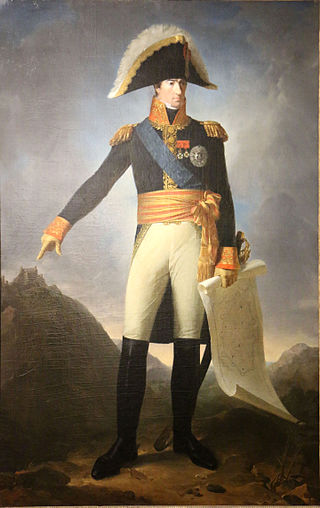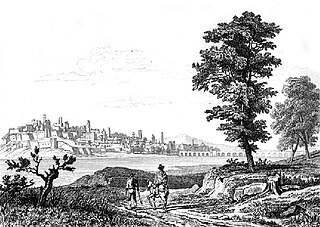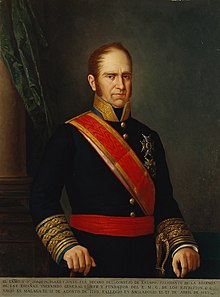
The Battle of Uclés saw an Imperial French corps led by Marshal Claude Perrin Victor attack a Spanish force under Francisco Javier Venegas. The French easily crushed their outnumbered foes, capturing over half of the Spanish infantry. Uclés is located in the province of Cuenca 15 kilometres (9.3 mi) east of Tarancón and 100 kilometres (62 mi) southeast of Madrid. The action occurred during what is called the Peninsular War in English-speaking countries and the Spanish War of Independence in Spain. The war was part of a larger struggle known as the Napoleonic Wars.

The Battle of Ocaña was fought on 19 November 1809 between French forces under Marshal Jean-de-Dieu Soult against the Spanish army under General Juan Carlos de Aréizaga, which suffered its greatest single defeat in the Peninsular War.

Honoré Théodore Maxime Gazan de la Peyrière was a French general who fought in the French Revolutionary Wars and the Napoleonic Wars.

The Battle of Albuera was a battle during the Peninsular War. A mixed British, Spanish and Portuguese corps engaged elements of the French armée du Midi at the small Spanish village of Albuera, about 20 kilometres (12 mi) south of the frontier fortress-town of Badajoz, Spain.

The Battle of Talavera was fought just outside the town of Talavera de la Reina, Spain some 120 kilometres (75 mi) southwest of Madrid, during the Peninsular War. At Talavera, a British army under Sir Arthur Wellesley combined with a Spanish army under General Cuesta fought in operations against French-occupied Madrid. At nightfall, the French army withdrew a short distance after several of its attacks had been repulsed; the allies, having suffered comparable casualties to the French, made no attempt to pursue.

The Battle of Barrosa was part of an unsuccessful manoeuvre by an Anglo-Iberian force to break the French siege of Cádiz during the Peninsular War. During the battle, a single British division defeated two French divisions and captured a regimental eagle.

The Siege of Cádiz was a siege of the large Spanish naval base of Cádiz by a French army from 5 February 1810 to 24 August 1812 during the Peninsular War. Following the occupation of Seville, Cádiz became the Spanish seat of power, and was targeted by 70,000 French troops under the command of the Marshals Claude Victor and Nicolas Jean-de-Dieu Soult for one of the most important sieges of the war. Defending the city were 2,000 Spanish troops who, as the siege progressed, received aid from 10,000 Spanish reinforcements as well as British and Portuguese troops.

Louis Henri Loison briefly joined the French Army in 1787 and after the French Revolution became a junior officer. Blessed with military talent and courage, he rapidly rose to general officer rank during the French Revolutionary Wars. He got into difficulties because of his fondness for plundering. In late 1795 he helped Napoleon Bonaparte crush a revolt against the government. After a hiatus, he returned in 1799 to fight in Switzerland where he earned another promotion. In 1800 he commanded a division under Napoleon in the Marengo campaign.

Édouard Jean-Baptiste, comte Milhaud was a French politician and Général de Division. He distinguished himself throughout the French Revolutionary and Napoleonic Wars and is considered one of the best generals of cavalry of Napoleon's army.

The Battle of the Gebora took place during the Peninsular War between Spanish and French armies on 19 February 1811, northwest of Badajoz, Spain. An outnumbered French force routed and nearly destroyed the Spanish Army of Extremadura.

The Battle of Lübeck took place on 6 November 1806 in Lübeck, Germany between soldiers of the Kingdom of Prussia led by Gebhard Leberecht von Blücher, who were retreating from defeat at the Battle of Jena–Auerstedt, and troops of the First French Empire under Marshals Murat, Bernadotte, and Soult, who were pursuing them. In this War of the Fourth Coalition action, the French inflicted a severe defeat on the Prussians, driving them from the neutral city. Lübeck is an old Baltic Sea port approximately 50 kilometres (31 mi) northeast of Hamburg.

In the Battle of Maguilla a British cavalry brigade led by Major General John Slade attacked a similar-sized French cavalry brigade commanded by General of Brigade Charles Lallemand. The British dragoons scored an initial success, routing the French dragoons and capturing a number of them. The British troopers recklessly galloped after their foes, losing all order. At length, the French reserve squadron charged into the British, followed by the French main body which rallied. With the tables turned, the French dragoons chased the British until the horses of both sides were too exhausted for the battle to continue. The action took place during the Peninsular War, near Maguilla, Spain, a distance of 17 kilometres (11 mi) northeast of Llerena.

Jean-Pierre-Antoine Rey commanded a famous French infantry regiment during the Napoleonic Wars and became a general officer in 1808. He led an infantry brigade in a number of actions in Spain and France. His brother Louis Emmanuel Rey was a French general of brigade who also served in Spain during the Peninsular War. Since most sources do not distinguish between the generals named Rey, the two are easily confused.

The Capitulation of Pasewalk on 29 October 1806 resulted in the surrender of Oberst (Colonel) von Hagen's 4,200 Prussian soldiers to an inferior force of two French light cavalry brigades led by Generals of Brigade Édouard Jean Baptiste Milhaud and Antoine Lasalle. The Prussians were completely demoralized after a two-week-long retreat following their decisive defeat at the Battle of Jena-Auerstedt. Pasewalk is 110 kilometers north of Berlin and about 40 kilometers west of Szczecin (Stettin), Poland.

The Battle of Bornos on 5 November 1811 saw a Spanish force led by Francisco Ballesteros attack an Imperial French column under Jean-Baptiste Pierre de Semellé. The action was part of a larger operation in which the French tried to trap Ballesteros but failed. Instead, the Spanish general lashed out at one of the French columns. The French escaped disaster when they fought their way out, but a French-allied Spanish battalion either surrendered or switched sides. Bornos is about 40 miles (64 km) northeast of Jerez de la Frontera on Route 342. The battle occurred during the Peninsular War, part of the Napoleonic Wars.

In the Battle of Zújar of the Peninsular War, part of the Napoleonic Wars, on 9 August 1811 an Imperial French division from Nicolas Soult's army attacked a Spanish division belonging to Manuel Alberto Freire de Andrade y Armijo's Army of Murcia. The French division, led by Nicolas Godinot, defeated Joseph O'Donnell's Spanish division with heavy losses. Zújar is located on Route 323, 13 kilometres (8 mi) northwest of Baza, Granada in Spain.

The second siege of Badajoz saw an Anglo-Portuguese Army, first led by William Carr Beresford and later commanded by Arthur Wellesley, the Viscount Wellington, besiege a French garrison under Armand Philippon at Badajoz, Spain. After failing to force a surrender, Wellington withdrew his army when the French mounted a successful relief effort by combining the armies of Marshals Nicolas Soult and Auguste Marmont. The action was fought during the Peninsular War, part of the Napoleonic Wars. Badajoz is located 6 kilometres (4 mi) from the Portuguese border on the Guadiana River in western Spain.

The Battle of Alcántara saw an Imperial French division led by Marshal Claude Perrin Victor attack a Portuguese detachment under Colonel William Mayne. After a three hours skirmish, the French stormed across the Alcántara Bridge and forced the Portuguese to retreat. The clash happened during the Peninsular War, part of the Napoleonic Wars. Alcántara, Spain is situated on the Tagus river near the Portuguese border, 285 kilometres (177 mi) west-southwest of Madrid.

The Battle of Arzobispo on 8 August 1809 saw two Imperial French corps commanded by Marshal Jean-de-Dieu Soult launch an assault crossing of the Tagus River against a Spanish force under José María de la Cueva, 14th Duke of Alburquerque. Alburquerque's troops rapidly retreated after suffering disproportionate losses, including 30 artillery pieces. El Puente del Arzobispo is located 36 kilometres (22 mi) southwest of Talavera de la Reina, Spain. The action occurred during the Peninsular War, part of a larger conflict known as the Napoleonic Wars.
The VI Cavalry Corps of the Grande Armée was a French military unit that had an ephemeral existence during the Napoleonic Wars. The corps was created on 9 February 1814 and General François Étienne de Kellermann was appointed as its commander. The corps was formed by combining a newly arrived dragoon division from the Spanish front, a second dragoon division, and a light cavalry division made up of hussars and Chasseurs-à-Cheval. The latter two divisions included units from the former III Cavalry Corps. Kellermann led the VI Cavalry Corps at Mormant, Troyes, Bar-sur-Aube, Laubressel, and Saint-Dizier. After Emperor Napoleon Bonaparte abdicated in early April, the corps ceased to exist.





















